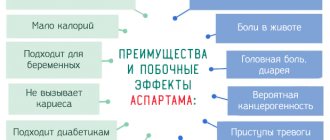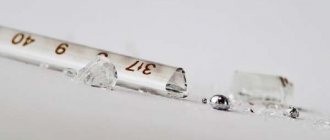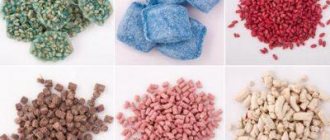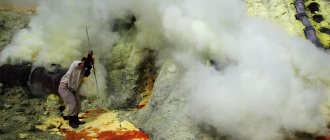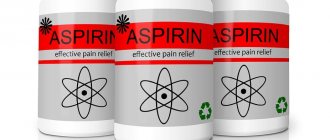Causes of the syndrome
The main causes of toxic liver damage are the entry of poisons into the body, that is, poisoning. These may include any substances that have a negative effect on internal organs and tissues and need to be eliminated (removed). All toxins can be divided into 2 categories:
- with direct hepatotoxic effect;
- with an indirect effect on liver tissue.
In the first case, poisons accumulate directly in the liver tissues, where they can enter through the bloodstream. They cause inflammatory processes in hepatocytes and gradually destroy them. The danger of such poisons depends not on their quantity, but on the degree of patient resistance to them. This feature is individual and transmitted genetically. Symptoms of liver damage from such substances often develop together with kidney problems.
The second group of poisons affects the liver indirectly and does not cause the death of red blood cells. Such substances disrupt blood circulation in small vessels that carry blood to the tissues of the organ. As a result, hepatocytes do not receive enough oxygen and die.
Antibiotics
Very often, people self-prescribe and start taking antibiotics for food poisoning. However, this is strictly forbidden! Most often, taking antibiotics does not in any way affect the causative agent of the disease. But the antibiotic still places a heavy burden on the kidneys and liver. But even without an antibiotic, they have to do a huge job - to remove all toxins from the human body. So is it worth putting additional stress on an organism that is already having a hard time?
And, in addition, the use of antibiotic drugs greatly changes the normal intestinal microflora, making it unable to fight toxins that enter the body with poor-quality food. Then, in order to restore the normal natural balance of microflora, you will have to make considerable efforts and spend quite a long time.
Although in some cases, intestinal infections cannot be avoided without an antibiotic. However, the doctor will first prescribe the necessary tests. And only if the tests show the presence of microorganisms in the body that are sensitive to the antibiotic, the doctor will prescribe the medicine.
Poisons with hepatotoxic effects
Toxic liver poisoning is a pathological condition in which foreign substances cause the death of its functional cells. These include food and medicines, chemicals and any other products that are harmful to the body.
The first category of toxic substances are medications. They can cause poisoning if taken for a long time or if the dosage is exceeded once. The most dangerous groups of drugs that can cause intoxication include:
- antibiotics and sulfonamides;
- steroidal anti-inflammatory drugs;
- specific antiviral groups of drugs;
- tablets taken to treat tuberculosis;
- drugs to relieve seizures.
Plants can also cause poisoning. Some of them are toxic when taken orally, and some can have a harmful effect on the body even through the respiratory system. Among the most poisonous plants are:
- weeds, including bitterling, groundsel and others;
- mushroom poisons - often poisoning is caused by representatives of the toadstool family;
- food products on which a fungus has formed during storage - it can produce the dangerous poison aflatoxin;
- other inedible foods and poisons that are produced during their storage and preparation (including potato solanine).
Regular alcohol consumption can cause liver toxicity
The metallurgical, oil and other industries use toxic substances. There are certain safety precautions with them, but you can get poisoned through negligence or if the rules are not followed. The following compounds are considered particularly dangerous:
- arsenic - necessary in the metallurgical industry for a number of chemical reactions;
- phosphorus - used in metallurgy and agriculture, as part of plant nutrition;
- pesticides - preparations for killing weeds;
- chlorinated carbohydrates - they can be poisoned at certain stages of oil production;
- aldehydes, which are used for chemical reactions to produce acetic acid;
- phenols - included in disinfectants;
- insecticides are preparations for killing insects.
Another type of liver damage is alcohol poisoning. The products of ethanol metabolism are a dangerous poison that can destroy liver cells. It is this organ that must participate in removing them from the body in order to avoid intoxication of brain cells.
Disease in children
In childhood, liver drug poisoning is observed less frequently than in adults. The likelihood of intoxication in children is minimal, since doctors extremely rarely prescribe heavy medications to young patients that can reduce liver function and lead to poisoning. However, in some cases, intoxication occurs due to accidental use of medications. The small organism responds to toxic substances by vomiting and raising body temperature.
The following drugs can cause liver toxicity in children:
- "Carbamazepine";
- "Paracetamol";
- "Erythromycin";
- "Acetylsalicylic acid";
- non-steroidal anti-inflammatory drugs.
Risk factors
Symptoms of toxic liver damage can occur in anyone. However, there is a list of persons who, for health reasons or other factors, will be more susceptible to poisons under equal conditions. At risk are:
- patients with chronic liver failure and other organic liver pathologies;
- with a tendency to allergic reactions;
- with hereditary weakness of liver enzyme systems;
- employees of chemical, pharmaceutical and other enterprises;
- persons with diabetes;
- with impaired fat metabolism in the body.
The constitution of a person also matters. If body weight is within normal limits, the risk of poisoning is reduced. Groups of people who are obese or, conversely, underweight are more likely to suffer from liver damage from chemicals.
Prevention
It is quite possible to reduce the risk of poisoning from minced meat and meat products if you adhere to the following rules:
- purchase meat products in specialized stores where sanitary control is carried out;
- read expiration date labels on meat products;
- do not buy bulging cans of meat - a sign of botulism;
- store meat in the freezer;
- keep separate cutting boards for fish and meat in the kitchen;
- use meat broth stored in the refrigerator for 2 days.
Basic measures prevent infection with dangerous infections. In case of botulism, they will save lives.
Meat poisoning poses a health risk. When purchasing a product, prepare and store it correctly. Never consume finished products that have been out of refrigeration for more than 2 hours.
The nutritional value of meat is provided by proteins, including valine, lysine, threonine, leucine and other amino acids, and lipids containing polyunsaturated fatty acids. In the human diet, it is a basic source of phosphorus, trace elements and vitamins. Its extractive components improve the taste of food and enhance the production of secretions by the digestive glands.
Symptoms of liver intoxication
During intoxication, liver damage occurs in direct or indirect ways. This is manifested by its inflammation, decreased function and associated symptoms. Depending on the clinical picture of poisoning and the changes that occur at the cellular level, liver damage syndromes are distinguished. A syndrome is a set of symptoms that appear together.
Liver damage may be associated with excess dosage of certain groups of drugs
Cytolysis syndrome
Cytolysis is the gradual destruction of the cell membrane of hepatocytes under the influence of poisons. First, the cells increase their permeability to various substances, and then, as a result of pressure differences, they can be destroyed. In the blood, there is a persistent increase in the activity of liver enzymes (ALT, AST), as well as an increase in the level of vitamins and iron, which are released from the liver cells.
Cholestatic syndrome
Cholestasis is stagnation of bile in the body. This syndrome occurs less frequently in cases of poisoning. It may be associated with inflammation of the liver parenchyma and compression of the bile ducts by organ tissue. Bile accumulates in the gallbladder and bile ducts without reaching the small intestine.
Typical manifestations of cholestasis may include:
- jaundice - staining of the skin and mucous membranes yellow with the bile pigment bilirubin;
- increase in liver volume;
- itching is the body’s reaction to irritation with bilirubin;
- darkening of urine and lightening of stool.
Cholestatic syndrome rarely occurs alone. More often it appears together with symptoms of other liver damage syndromes.
Dyspeptic syndrome
The complex of phenomena that are expressed by disruption of the digestive tract is called dyspepsia. The liver performs a number of important functions in the digestive process. It produces bile to emulsify and process fats in the small intestine. In addition, poisons are eliminated from the body through the gastrointestinal tract. In the process of their disposal, they irritate the walls of the stomach and intestines, causing a complex of characteristic symptoms:
Liver intoxication and its treatment
- loss of appetite, sudden weight loss;
- nausea and vomiting;
- pain in the right hypochondrium and in the navel area, which can spread to the entire abdominal wall;
- flatulence and bloating.
With organic liver damage, these manifestations are complemented by an increase in the volume of the organ. The liver protrudes beyond the edges of the costal arch and is painful on palpation. Jaundice syndrome also develops.
Liver cirrhosis is one of the most severe liver diseases. It can also be caused by poisoning with toxic substances. At the cellular level, hepatocytes are destroyed with the formation of a dense connective tissue scar. It does not go away with conservative treatment and significantly reduces the ability of the organ to perform its functions. Cirrhosis can be identified by acute pain in the right hypochondrium, yellowness of the skin and sclera, an increase in the volume and weight of the organ. When hepatic circulation is impaired, blood stagnates in the veins of the abdominal wall - they are enlarged and filled with blood. The strength of the vascular walls also decreases: the patient develops spider veins on the skin, and the tendency to form hematomas increases.
Hepatic encephalopathy
Toxic damage to the liver from drugs and other substances can lead to dangerous complications. Poisons, unable to be eliminated from the body, circulate in the blood and can poison the cells of the central nervous system. With a mild degree of encephalopathy, a complex of nervous disorders associated with apathy, irritability, and memory impairment develops. If treatment is not started at this stage, hepatic coma may develop.
Liver poisoning occurs in different forms, one of them is jaundice
What is poisoning characterized by?
Signs of liver disorders that have developed under the influence of substances harmful to this organ depend on a number of individual factors, such as the type of poisoning, its source and the rate of development. An important role is played by the general state of health, the strength of the immune system, lifestyle and many other nuances that make up the overall picture of the state of the body.
The main distinguishing features of poisoning (which can be attributed to both any type of intoxication and that which does not depend on the type of toxic substance) include the physiological state of the liver.
In the initial stage, at which toxic elements settle and accumulate in the cells, the organ is always enlarged, and upon palpation it gives the impression of softness and even looseness. No specific symptoms are observed at this time.
What to do and where to go - a person thinks about these questions already at the second stage of poisoning, when the liver begins to hurt. Physiologically, during this period there is a sharp contraction of the organ, a decrease in its volume, which occurs due to the death of cells that were previously swollen under the influence of toxins. Palpation gives a feeling of hardness; in fact, the liver resembles a small stone.
In addition to physiological signs, liver cell poisoning can be recognized by the presence of the following symptoms:
- periodic pain or pulling sensations in the right side and under the ribs on the right;
- increased sensitivity to odors;
- changes in the consistency and color of stool;
- unpleasant specific odor from the mouth;
- fatigue, general lethargy;
- disturbance in the integrity of sleep, lack of a feeling of rest after waking up;
- frequent migraines;
- periodic increase in temperature;
- belching with a strong “rotten” odor;
- muscle spasm on the right when moving up the stairs;
- various skin rashes;
- thinning and hair loss;
- frequent allergy attacks;
- easy susceptibility to infectious respiratory diseases;
- yellowing of the skin and whites of the eyes.
During medical examinations in a hospital setting, doctors diagnose conditions called “syndrome” - cytolysis, dyspeptic, cholesteric. These signs include a set of physiological changes and symptoms directly felt by the person himself.
Quite often the liver hurts after stomach poisoning; such pain is not a sign of organ intoxication. As an independent pathology, they report only that. that not all toxins have left the body. and the liver itself cannot cope with cleaning it from harmful components.
Forms and degrees
Toxic liver damage can occur with different clinical signs and varying degrees of severity. In this regard, there are 3 main degrees of organ damage, which are determined based on the results of a biochemical blood test:
- 1st degree - the activity of liver enzymes increases no more than 5 times;
- 2nd degree - up to 10 times;
- 3rd degree - more than 10 times.
Poisoning can occur in acute or chronic forms. The first is typical for a one-time, one-time intake of large doses of toxins, manifested by an acute onset and more pronounced clinical symptoms. Chronic poisoning is diagnosed in individuals who regularly come into contact with small amounts of poisons that tend to accumulate in the body.
All forms of liver damage by toxins can be divided into several forms:
- with manifestations of cholestasis;
- with symptoms of hepatitis (acute or chronic);
- occurring as an autoimmune reaction - an allergy to poisons, which occurs with inflammation of the liver;
- with fibrosis - a process in which healthy functional liver tissue is replaced by dense connective tissue (the first stage of cirrhosis);
- with the appearance of neoplasms, cavities with blood, blockage of blood vessels and other phenomena.
In most cases, concomitant liver damage is observed. Signs of damage are combined, and the patient exhibits symptoms of several syndromes simultaneously.
Drugs
In some cases, liver intoxication must be treated for a long time, resorting to the use of medications. The therapeutic course includes taking the following medications:
- glucose and vitamin complex to restore the body;
- hepatoprotectors;
- amino acids;
- antiallergic drugs;
- antibiotics;
- medications to reduce accumulated fat in the liver;
- medications with sedative properties.
Diagnostic methods
Poisoning with various drugs must be distinguished from other liver diseases, which manifest themselves with similar symptoms. At the initial examination, it is important to determine the fact of contact with toxic substances and find out the presence of chronic liver diseases. They can be congenital or acquired, but equally increase the risk of developing complications from poisoning.
Next, a set of necessary studies is carried out:
- Ultrasound of the liver and gallbladder;
- elastography - examination of liver tissue if fibrosis is suspected can be used instead of biopsy (analysis of a small area of tissue under a microscope);
- MRI, CT if necessary, three-dimensional visualization of the organ’s condition;
- fibroesophagogastroduodenoscopy - examination of the mucous membrane of the digestive tract using a probe, as well as taking their contents for analysis.
Data from a biochemical blood test will allow you to assess the overall picture of poisoning
A more complete picture can be obtained based on data from analyzes of biological fluids of the body:
- general blood test with counting of cellular elements;
- blood biochemistry to assess the activity of liver enzymes;
- urine tests for the presence of proteins and bile pigments;
- diagnostics of blood clotting processes;
- determination of antibodies to viral infections.
In diagnosis, it is important to distinguish between hepatitis and other liver diseases caused by the intake of poisons and toxins. The cause of liver damage will influence the selection of treatment regimen.
Rehabilitation period
During the recovery period, it is prohibited to drink alcohol. It can cause new poisoning, leading to tissue necrosis and death.
During rehabilitation, it is important to follow a special diet. You should avoid harmful foods for at least 2 months after getting rid of the symptoms of intoxication. Subsequently, prohibited foods must be introduced into the diet carefully.
Every month it is worth visiting a doctor and undergoing examinations. At any moment there is a risk of exacerbation of intoxication. This is often observed when medical recommendations are violated.
Treatment of liver intoxication
All therapeutic measures are aimed at eliminating contact with the toxic substance and restoring the structure of the liver. Some patients will have to stop taking the medications that caused the intoxication, or change their occupation. If the poison can be identified, antidotes can be used. They are specific compounds - antidotes to certain toxins. If such antidotes do not exist, the general treatment regimen is applied.
Drug treatment
In case of poisoning, a standard regimen of detoxification of the body is prescribed, that is, binding and removing poisons. To do this, the following procedures may be necessary:
- gastric lavage;
- blood purification with devices (plasmophoresis);
- forced diuresis - drip administration of a large amount of liquid to reduce the concentration of poisons in the blood and speed up their removal in the urine;
- hepatoprotectors - drugs that protect liver cells from destruction and stimulate tissue repair;
- if necessary - antibacterial agents;
- medications that have the ability to bind ammonia - this will prevent damage to the central nervous system;
- antihistamines - to relieve signs of allergies.
The drugs are administered intravenously, in the form of injections or infusions (drips). The catheter is most effectively placed on the umbilical vein. This vessel is anatomically connected to the portal vein of the liver, so the medicinal substances will reach the organ in full.
Surgical intervention
In most cases, drug treatment is sufficient. Surgical intervention is indicated only in advanced cases when areas of the liver are damaged by cirrhosis. Since it is impossible to get rid of scars in functional tissue, a decision may be made to perform a partial liver resection.
During the treatment period, it is important to relieve the liver as much as possible and monitor your diet.
Additional Methods
During the treatment period, it is important to follow a gentle diet that will relieve excess stress on the liver. Diet No. 5 has been developed for such patients. It can be prescribed regardless of the cause of liver damage. Its main principles:
- eat food often, but in small portions;
- give up animal fats, spicy and fried foods, sweets and carbonated drinks;
- The basis of the diet should be vegetables and fruits, lean meats and fish, boiled or steamed;
- limit the consumption of salt and spices;
- Drink milk every day - it is also recommended for employees of industrial enterprises.
It is important for persons who, due to their occupation, come into contact with toxic chemicals, follow safety precautions. You can only work with toxins in special clothing that protects the skin, mucous membranes and respiratory tract.
First aid
If symptoms of poisoning appear, you need to consult a doctor who will prescribe treatment. There is no point in delaying this. If the case is not serious and treatment is not needed, so much the better for the patient. But in the event of a real threat to life, the doctor and his treatment will save the person. But a doctor or an ambulance cannot appear at the house in a few minutes; sometimes they have to wait for an hour or even longer. What to do in this situation, how to help the patient at home?
- Rinse the stomach. If the first signs of poisoning appear, you should immediately begin treatment at home. You need to rinse your stomach. To do this you need boiled warm water. How much is needed? Approximately 2 liters. You can add a little baking soda or potassium permanganate to it. The patient should drink the prepared water and, pressing his fingers on the root of the tongue, induce vomiting.
- Give a person activated carbon or another sorbent. It will remove the remains of bacteria and toxins.
- Cleanse the intestines. To do this, you can do an enema or drink magnesium sulfate (laxative). You should not drink a saline laxative; such treatment can be harmful, as diarrhea will worsen.
- Prevent dehydration. To do this you need to take 3-4 tsp. Regidrona or just water every 10 minutes.
If symptoms of poisoning appear, you should consult a doctor
The doctor must continue treatment. Before his arrival and after, the patient requires a strict diet; it is better to refuse food altogether. It is better to ask your doctor how much and what you can eat. But for 2-3 days, protein and fatty foods are contraindicated for him.
Sometimes signs of poisoning can be from overeating. A person does not indulge himself in delicacies, but eats a lot of chicken at once. Because of this, mild protein poisoning occurs: the temperature will rise slightly, pain will appear in the intestines, and the stomach will swell. These symptoms will go away quickly and no treatment is needed. You can do an enema or not eat for a while. This type of chicken poisoning is not dangerous.
Poisoning from meat products can be life-threatening, so it should not be treated at home. You need to call a doctor or call an ambulance. If you provide the patient with the necessary help in time, everything will end well.
Food poisoning
appear after eating food that contains bacteria and their poisons. When spoiled products are stored incorrectly and for a long time, harmful substances spread and toxins accumulate. At the same time, superficial, taste criteria do not change.
Heating or cooking does not protect against food poisoning
, because toxins do not decompose when exposed to temperature. The disease develops quite quickly, and after a few hours the condition worsens.
The following manifestations and symptoms of the disease are sharply detected: nausea, dizziness, pain in the upper abdomen, the person becomes pale, the limbs become cold
. The disease is severe, but it can be treated quickly enough if action is taken to treat these syndromes. However, weakness will persist for several days.
The main method of treating food toxin poisoning
gastric lavage. It is recommended that this process be carried out using a thick probe. The main thing is to induce vomiting in the patient; to do this, you need to drink within 1.5 liters of warm, clean water or 2% baking soda dissolved in water.
Vomiting removes contaminated food and germs with their toxins. The faster the stomach is cleansed, the much easier it will be for the patient in the future. If the patient vomits spontaneously, then the stomach needs to be rinsed later. Cleansing can be completed only after the liquid coming out with vomiting is clear.
At the end of the procedure, the patient needs to use a saline laxative. In case of fainting, the victim should be given ammonia to inhale. Hot and sweet tea is recommended and warming with heating pads is advisable.
You can eat only foods that are easy for the stomach, these are: various non-concentrated broths or soups, boiled meat products, cereals, omelettes. To increase the speed of digestion, you need to take tablets, such as: festal, pepsin, panzinorm
, they need to be drunk one mixture during or after finishing a meal. It is not recommended to use other medications.
In case of intoxication with methyl alcohol
The first step is to induce vomiting in the patient. You should cleanse your stomach several times immediately after intoxication and throughout the day.
If a patient is poisoned with ethyl gasoline
You need to urgently take the victim to clean air, loosen the waist belt and free the neck area. If breathing disturbance is noticeable, it is necessary to give the patient ammonia, and if breathing does not normalize, then artificial respiration is necessary
Protein food is necessary for the body as a building material, as well as a source of microelements and vitamins. But not every product can be consumed without fear; for example, you can often get poisoned by meat.
Intoxication develops for various reasons - from insufficient compliance with sanitary regulations when cutting carcasses to the ingress of bacteria during food preparation and storage.
Complications and prognosis
With timely treatment, all signs of intoxication disappear without consequences. However, if toxins continue to enter the body, there remains a risk of developing dangerous complications:
- cirrhosis - replacement of the liver parenchyma with connective tissue, which may be accompanied by ascites and varicose veins of the abdominal wall;
- chronic liver failure;
- renal failure;
- hepatic encephalopathy and hepatic coma.
The liver is the organ that suffers first in case of poisoning. With any type of intoxication, it is important to remove toxic compounds from the body in a timely manner and prevent their further entry. The prognosis will depend on the timeliness of treatment. Under equal conditions, poisoning can pass without consequences or become the cause of chronic diseases of the liver, kidneys, nervous and other systems.
Giving help
Whatever the food poisoning, treatment should always be timely to avoid irreparable consequences. If you or someone close to you has been poisoned by meat, you need knowledge of how to help at home.
Pre-medical measures
Calling an ambulance, even with minor symptoms, is still advisable.
This is necessary for a correct diagnosis, clarification of possible complications and determination of the correct further treatment.
First aid should aim to eliminate microbes and the toxins they produce from the body. It consists of the following measures:
Drink rehydron in small sips every 10 minutes
- Gastric lavage and inducing vomiting.
To do this, you can give a weak solution of potassium permanganate or soapy water (soap milk). Repeat the procedure until the vomit contains no remnants of eaten food. - Cleansing the intestines by taking laxatives (sodium sulfate).
Or give an enema. The use of saline laxatives is strictly prohibited. Because they will worsen diarrhea. - Use of absorbent drugs.
These can be such as enterosgel, filterum STI, polysorb, activated carbon. - Taking medications whose action is aimed at restoring water-salt balance.
To do this, prepare a solution of rehydron or WHO powder. Drink in small sips at intervals of 10 minutes.
If fish poisoning occurs, the victim should be given a glass of water with soap (soap milk) before medical workers arrive. Then give a laxative and do a deep cleansing enema (add 2 tablespoons of castor oil to 1 liter of water).
Rub the body with a cloth soaked in vinegar or vodka, and place a heating pad with warm water on the stomach.
Then give the victim strong tea, maybe a little strong wine. Strong coffee, drunk every half hour, helps relieve symptoms.
Diet
Diet is of great importance in eliminating toxic substances from the liver. While adhering to proper nutrition, it is necessary to avoid eating smoked meats, spices, spicy and salty foods. It is strictly forbidden to drink alcoholic beverages, as they are toxins. During treatment, you should minimize the intake of heavy foods such as corn, cucumbers, legumes, tomatoes, etc.
It is allowed to include chopped vegetables and fruits in the diet, which are previously heat-treated in a double boiler or in a large amount of water. You can consume fermented milk and dairy products in large quantities. Doctors recommend boiling and baking lean meats, and finely cutting them before serving.
Folk remedies
To speed up the process of removing toxins from the liver, you can use folk remedies. However, before using alternative medicine, you need to make sure that there is no allergic reaction to the herbal components that are part of traditional recipes.
Viburnum decoction is considered an effective remedy. To prepare, you will need to pour 50 g of viburnum berries into a liter of water and let it boil for an hour. Strain the broth, cool and drink between meals throughout the day until the entire volume of liquid has been drunk.
Another effective remedy is a decoction based on rose hips. You need to cook 50 g of fruits for three hours, then strain them and leave them in a warm place for five hours. Next, you should boil the broth again, cool slightly and add 50 g of honey to it. You need to drink a glass of medicinal liquid in the morning and evening.
Aloe leaves can also remove toxins from the liver. You need to take 300 g of leaves, wash them and grind them using a meat grinder. Add 200 g of honey to the resulting mass and mix. The medicinal product is left to infuse for a week, and after the time has elapsed, 50 g are consumed before each meal.
Manifestation of toxic infection
Meat poisoning occurs at home and in public places. Sometimes the disease does not appear immediately; the formation of specific signs depends on the amount of product consumed and the type of toxin. The higher the level of pathogenic bacteria in the stomach, the shorter the incubation period, the more pronounced the symptoms of the disease.
Symptoms:
- Nausea;
- Vomit;
- Frequent diarrhea;
- Abdominal pain;
- Pain in the epigastric region;
- Increased temperature up to 40 degrees;
- Rapid or slow heartbeat;
- Weakness;
- Muscles and headaches hurt;
- Low or high blood pressure.
What is the danger of poisoning
Consumption of low-quality meat products disrupts the body’s normal functioning. Against this background, there is a risk of developing chronic diseases.
With pancreatitis, the pancreas suffers. The carrier of the disease suffers from abdominal pain, frequent vomiting, and difficulty passing stool.
Eating spoiled meat can cause gastritis. It’s enough to treat yourself to bad minced meat a couple of times, and the inside of the stomach will become inflamed after a dose of toxic substances.
Low temperature treatment of meat products can infect a person with worms. The disease trichinosis is dangerous for the heart; the pathogens, Trichinella, affect many organs and muscles.
How many hours does it take for intoxication to appear?
After eating a rotten meat product, the initial symptoms will appear within 2 hours. It’s easy to get poisoned by pork, dumplings, and even barbecue - all you need to do is not maintain personal hygiene, store the food incorrectly, and poorly heat-treat the food.
There are hundreds of infectious agents with characteristic symptoms known.
- Staphylococcus. An infected person is characterized by weakness, colic, vomiting, severe headache, and diarrhea.
- Salmonellosis. Toxins affect the body within 5-6 hours, causing fever, diarrhea, and vomiting. Treatment must be immediate. Diarrhea may last for several days, then dehydration begins.
- Dysentery. The disease appears a couple of hours after eating spoiled meat. Symptoms: fever, muscle aches, chills, fever, increased gas, diarrhea.
- Botulism is a terrible infection that can be fatal. The patient feels weakness, headache, blurred vision and numbness of the facial muscles due to damage to the nervous system.
Sometimes people do not suspect that they have been poisoned; symptoms may not include diarrhea and vomiting. People who eat undercooked cutlets, raw and half-raw meat often get sick. Those who like to eat steaks of different degrees of doneness are advised to be careful when choosing a product!

